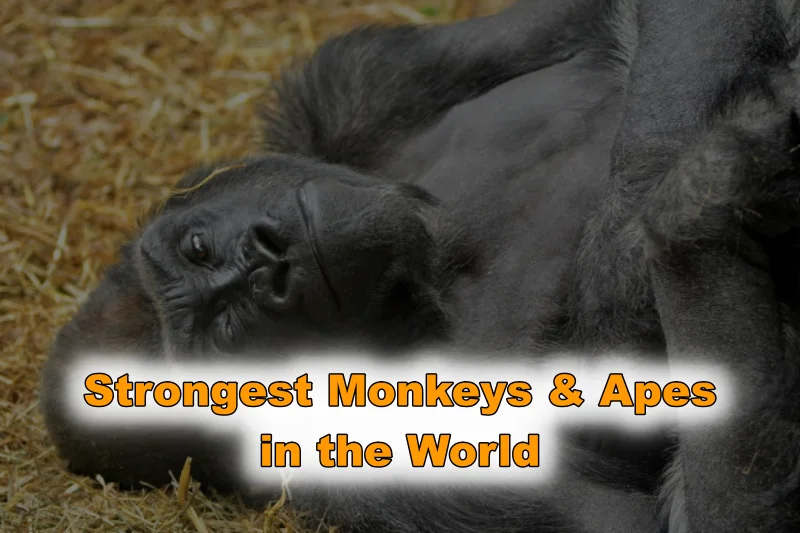Monkeys and Apes are the closest relatives to us humans, and they all come in various sizes and appearances. The plethora of primate species includes the world’s smallest to the world’s strongest and most prominent members, of which even humans are a part.
With so many members, one question often keeps surfacing, which monkey species are the strongest? To aid you with the answer, we bring you a list of the Top 15 Strongest Monkeys and Apes in the World. The ranking has been made based on their size and musculature.
Top 15 Strongest Monkeys & Apes in the World
15) Vervet monkey
| Scientific Name | Chlorocebus pygerythrus |
| Size | 40 to 60 cm (16-24 inches) |
| Life Span | Up to 30 years |
| Location | Southeastern Africa |
| Diet | Wild fruits, flowers, leaves, seeds, and seed pods |
This southeast African species is frequently used as a non-human primate model by researchers due to their similar characteristics like hypertension, anxiety, and alcohol consumption.
They are olive or gray in color, lighter on the underside, and can be easily identified by their bright blue scrotum. The habitat of these monkeys includes savanna, riverine woodland, coastal forest, and mountains.
14) Colobus monkey
| Scientific Name | Colobus angolensis |
| Size | 50 to 70 cm |
| Life Span | 20-30 years |
| Location | Africa |
| Diet | fruit, seeds, on ripe fruit, supplemented with full-grown leaves |
This nocturnal and diurnal mammal can be found in Africa’s deep rainforests, from Angola to Zambia. These monkeys have black faces and black fur that is bordered by white hairlocks. White hairs can also be found on the shoulders.
They are folivores, which implies that leaves comprise the majority of their food. The infants are completely different from the adults since they are all white.
13) Rhesus macaque
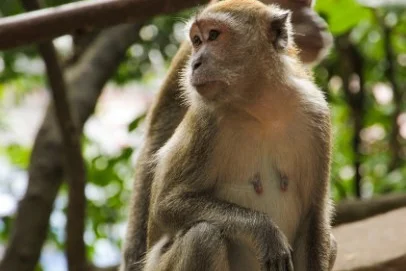
| Scientific Name | Rhesus macaque |
| Size | on average 53.18 cm |
| Life Span | 20-40 years |
| Location | South, Central, and Southeast Asia |
| Diet | plant material, insects, spiders, crustaceans, and bird’s eggs |
Commonly found in the Indian Subcontinent and Southern Asia, the Rhesus Monkey is the tenth strongest monkey on today’s list.
Spotted roaming around in the streets or jumping from one building to the other, these monkeys are quite bad and reputed for lifting edible items from shops and open homes.
With their average body length being 20 inches, they weigh approximately 7.5-8 kilograms. Their habitat ranges from urban areas to forested areas.
12) Langurs
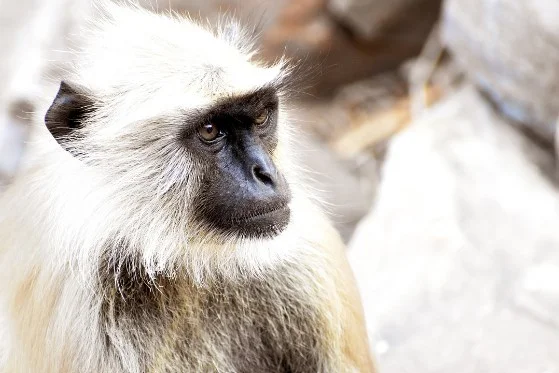
| Scientific Name | Semnopithecus entellus |
| Size | 51 to 79 cm |
| Life Span | 18-30 years |
| Location | Indian Subcontinent |
| Diet | leaves, fruits, twigs, and buds |
Another monkey species found in the Indian Subcontinent and the adjoining areas come in up to seven species spread throughout the land. Their habitat also includes densely populated areas of grasslands and forests.
Their body length reaches up to 30 inches, with a tail as long as 40 inches. They are the largest monkey species in the subcontinent and are sometimes known to carry off human babies if left outside the house. They mostly forage on fruits and other plant matter.
11) Spider monkeys
| Scientific Name | Ateles |
| Size | 36 to 66 cm |
| Life Span | 22 years |
| Location | Central and South America |
| Diet | fruits, nuts, insects, leaves, bird eggs, bark and honey |
These new-world monkeys are found in the tropical forests of Central and South America. They got their names from spider monkeys due to their prehensile tail and disproportionately long limbs.
The groups of these diurnal animals are led by females. Spider monkeys have a more complex social system than howler monkeys, probably due to their large brain size. They live in loose groups of 15 to 25 individuals. After gibbons, they are considered the most agile monkeys.
10) Howler monkeys

| Scientific Name | Alouatta belzebul |
| Size | 60 to 65 cm |
| Life Span | 15-20 years |
| Location | Southern Brazil, Paraguay, eastern Bolivia, and northern Argentina |
| Diet | leaves, as well as fruits, nuts, and flowers |
Howler monkeys, the 9th in our list of Strongest monkeys in the world, derive their name from the howling noises they make, which can travel long distances.
They are the largest species among the group of New World Monkeys, with a body length of nearly 35 inches.
Their tails are exceptionally long, sometimes reaching up to five times their body length. Their diet mostly includes fruits, nuts, and leaves or occasionally eggs.
9) Proboscis monkey
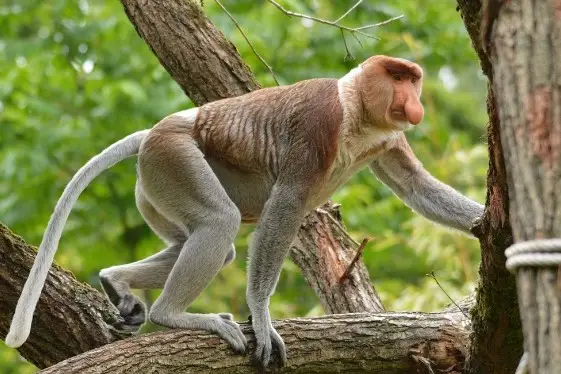
| Scientific Name | Nasalis larvatus |
| Size | 60 to 70 cm |
| Life Span | up to 20 years |
| Location | Borneo |
| Diet | fruit and leaves |
These large species of monkeys are native to the island of Borneo and are characterized by their long-hanging nose. Males have a body length in the range of 25-30 inches, with the females being a bit shorter.
They weigh anywhere between 9-12 kilograms, with females being a bit lighter. Their diet is primarily vegetarian, with insects and their larvae being on the occasional list.
8) Japanese macaque
| Scientific Name | Macaca fuscata |
| Size | 52 to 57 cm |
| Life Span | up to 32 years |
| Location |
Japan (Blakiston’s Line: Honshu, Shikoku, and Kyushu)
|
| Diet | fruits, nuts, seeds, herbs, soil and fish |
The next monkey we have on our list is the Japanese macaque, which is also commonly known as the snow monkey due to its habitat. Japanese macaques are medium-sized, stocky monkeys with relatively short tails.
Males (22 inches) are comparatively larger than females (20 inches). They are quite social and live in matrilineal societies, and their troops generally consist of up to 200 individuals.
The most interesting thing about them is that they can develop different accents just like human beings.
7) Gelada
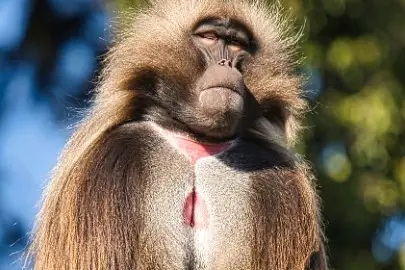
| Scientific Name | Theropithecus gelada |
| Size | 50 to 75 cm |
| Life Span | up to 30 years |
| Location | Ethiopian Highlands |
| Diet | leaves of grasses, fruits, invertebrates, and crops |
A glance at Animal Planet or National Geographic will often show us a species of monkeys with red chests wandering in the grasslands. Yes, you have guessed it correctly; we are talking about the Geladas.
Reaching a body length of approximately 20 inches, with an average weight of 17 kilograms, Geladas are the seventh strongest monkey species on the planet.
Sexual dimorphism exists, where males are heavier than females, characterized by the presence of a cape of hair on their backs. They primarily live in the grasslands, with grasses being their primary diet.
6) Drill
| Scientific Name | Mandrillus leucophaeus |
| Size | up to 70 cm |
| Life Span | up to 20 years |
| Location | southeastern Nigeria to western Cameroon and on Bioko Island |
| Diet | fruits, leaves, as well as invertebrates, generally termites |
The drill monkey is one of the largest monkeys in the world. They are short-tailed monkeys with an overall length of up to 70 cm and weighing not more than 20 kg.
Don’t underestimate them with their short size, they are very powerful. Their strength is parred with many monkeys and know how to defend their territory.
They are compared with mandrill. If we talk about their physical characteristics, then make Drills have incredibly colorful buttocks with shades of reds, blues, and purples. This coloration defines the status of males in the group.
On the other hand, female Drills are less colorful and totally different from males. Male Drill monkeys can be very aggressive during the fight.
5) Cape Baboon
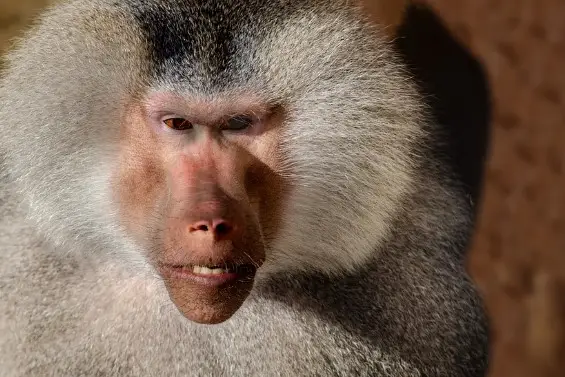
| Scientific Name | Papio ursinus |
| Size | 50 to 115 cm |
| Life Span | 30 to 40 years |
| Location | Southern Africa |
| Diet | bulbs, shoots, roots, seeds, fruit, invertebrates, small vertebrates, and seashore life |
The Cape Baboon is one of the six Baboon sub-species and its largest member. They have distinct muzzles, highly strong jaws, and large canines (2-3 inches long) and exhibit sexual dimorphism.
They mostly wander in the Savannah grasslands in Africa and forage on fruits, grasses, seeds, smaller rodents, young antelopes, and smaller species of monkeys.
Baboons are often found to lift the young ones of leopards, lions, and hyenas and kill them, therefore creating constant friction among the Savannah predators.
4) Mandrill
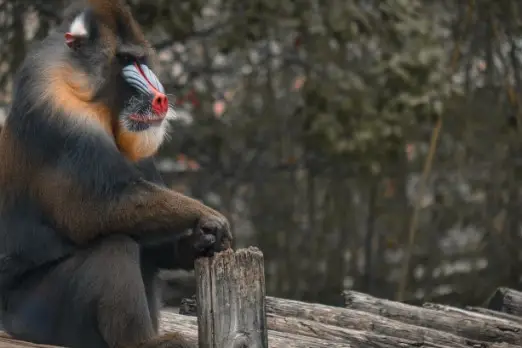
| Scientific Name | Mandrillus sphinx |
| Size | 70 to 95 cm |
| Life Span | 20 years |
| Location | west central Africa |
| Diet | fruit, seeds, leaves, fungi, roots, tubers, insects, snails, worms, frogs, lizards, bird eggs, snakes, and small vertebrates |
Mandrills are the largest species of monkeys on the planet and undoubtedly one of the strongest. They have a head-body length of nearly 35 inches with an average shoulder height of 22 inches.
The sexual dimorphism in this species is most pronounced among all monkeys, where females are less bulky and have shorter snouts.
The snouts in Mandrills is one of the major characteristic feature, where they have a red line running from their forehead to their nose and blue coloration on their sides with 6-7 grooves.
Their diet is quite similar to baboons, as they are omnivorous and feed plant products and also smaller animals.
3) Orangutan
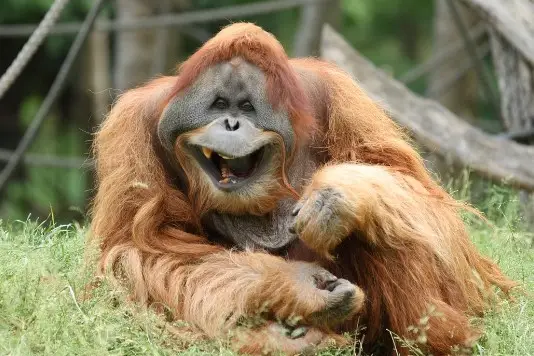
| Scientific Name | Pongo pygmaeus |
| Size | 1.25 to 1.5 m |
| Life Span | 35-45 years |
| Location | Indonesian and Malaysian Rainforests |
| Diet | fruits |
The members now shift from monkeys to apes, with the third position in our list of Strongest Monkeys in the world being occupied by Orangutans.
They are large maroon or brownish-red-haired creatures with long arms that may reach up to a length of 2 m. Orangutans have a standing height of nearly 4.5 ft and may weigh as much as 75 kg.
Their sexual dimorphism is also quite pronounced, whereas males are larger and have a distinct flat cheek pad. They are mainly fruit eaters but may sometimes shift to birds and other small vertebrates.
2) Chimpanzee
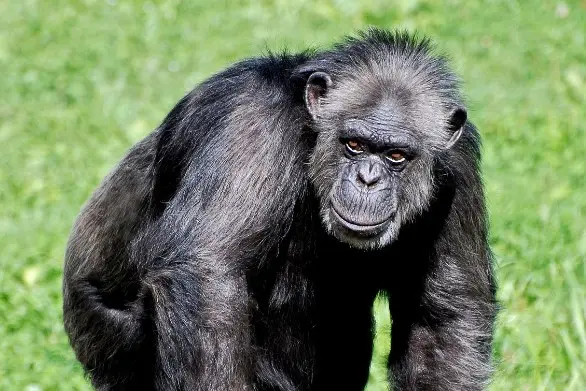
| Scientific Name | Pan troglodytes |
| Size | up to 1.5 cm |
| Life Span | 30-40 years |
| Location | forests of Central Africa |
| Diet | fruits, seeds, nuts, leaves, flowers, and insects |
The second position in our list of the Top 10 strongest monkeys in the world goes to Chimpanzees. Remember the movie, The Rise of the Planet of the Apes? Well, though it was a highly exaggerated version, Chimpanzees are quite strong beings.
Their standing height is approximately 5 ft, with males weighing as much as 80 kilograms. Females are slightly shorter and less heavy than males.
Chimpanzees are one of the most intelligent beings and bear similarities to humans to a great extent, both genetically and behaviorally.
Like humans, they have been found to use stones and sticks as tools to get their jobs done. They follow an omnivorous diet, feeding on plant products and smaller monkey species, young antelopes, hogs, etc.
1) Gorilla
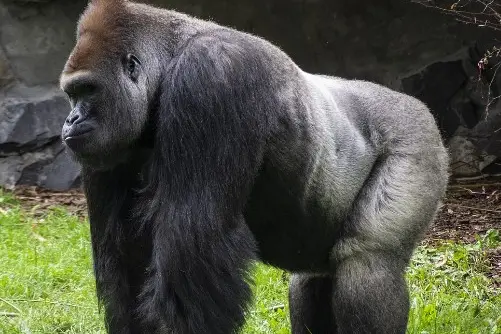
| Scientific Name | Gorilla gorilla, Gorilla beringei |
| Size | up to 1.8 cm |
| Life Span | 35-40 years |
| Location | Equatorial Africa |
| Diet | stems, bamboo shoots, and fruits |
Gorillas are the largest primates on the planet and the strongest of all. These smaller “King-Kongs” are very close relative to humans, with their height being anywhere between 5ft to 5.11 ft.
Their body weight ranges from 150-250 kg, with females being shorter and weighing less than males.
Despite their huge sizes, they are primarily herbivores and feed on grasses, leaves, plant roots, and other foliage. Beating their chest is the most characteristic behavior of Gorillas.
Their physical strength is immense, where video evidence has shown them pulling a 6.3 ft tall man with just one hand with utmost ease.
Conclusion
In conclusion, the world of monkeys and apes is vast and diverse, with over 250 species found across the globe. While all of these primates are fascinating and unique in their own way, some stand out for their incredible strength and power.
The top 10+ strongest monkeys and apes in the world are a testament to the impressive physical abilities of these animals.
From the mighty gorilla, which can lift up to ten times its body weight, to the acrobatic spider monkey, which can swing through the trees with incredible speed and agility, these primates are truly awe-inspiring.
Other strong primates on the list include the orangutan, chimpanzee, and mandrill, each with their own unique adaptations and strengths.
Overall, studying these powerful primates can provide us with a greater appreciation for the incredible diversity and complexity of life on Earth, and inspire us to take better care of our planet and its inhabitants.
So, our article on “Top 15 Strongest Monkeys in the World” concludes. We will be bringing more informative articles shortly. So stay tuned for it, or you can also go through our other fun and exciting articles.
Frequently Asked Questions:
Q1) What is the strongest of all apes?
Ans. Gorillas are the strongest of all the apes.
Q2) Which monkey is more aggressive?
Ans. Mandrills are considered the most aggressive monkeys in the world.
Q3) Which is stronger? Gorilla or monkey?
Ans. Gorillas are stronger than monkeys.
Q4) Are gorillas stronger than mandrills?
Ans. Gorillas are undoubtedly stronger than mandrills.
Q5) Can an ape beat a lion?
Ans. No, an ape can’t beat a lion. The lion would most likely win in a fight against the ape.
Q6) Who wins, gorilla vs. bear?
Ans. A grizzly bear can easily beat a gorilla.
Q7) What is a monkey’s worst enemy?
Ans. Humans are the worst enemies of monkeys.
Q8) What is the most advanced monkey?
Ans. Capuchin monkeys are the most advanced monkeys in the world.
Q9) What is the safest monkey in the world?
Ans. The Northern Muriqui monkey is considered to be the safest monkey in the world.
References:
Wikipedia, Animal bio, A-Z animals
Also Read:
Top 15 Most Expensive Lizards Worldwide (Ranked) 2023 Updated
Are There Any Pink Frogs? 6 Frogs That Are Pink

Being a zoology student I’m always been fascinated toward animals especially insects. I love to do research and learn about different animals. As a writer I want to share my thoughts about nature through my articles. Apart from this you can find me exploring the new places and voice notes.
